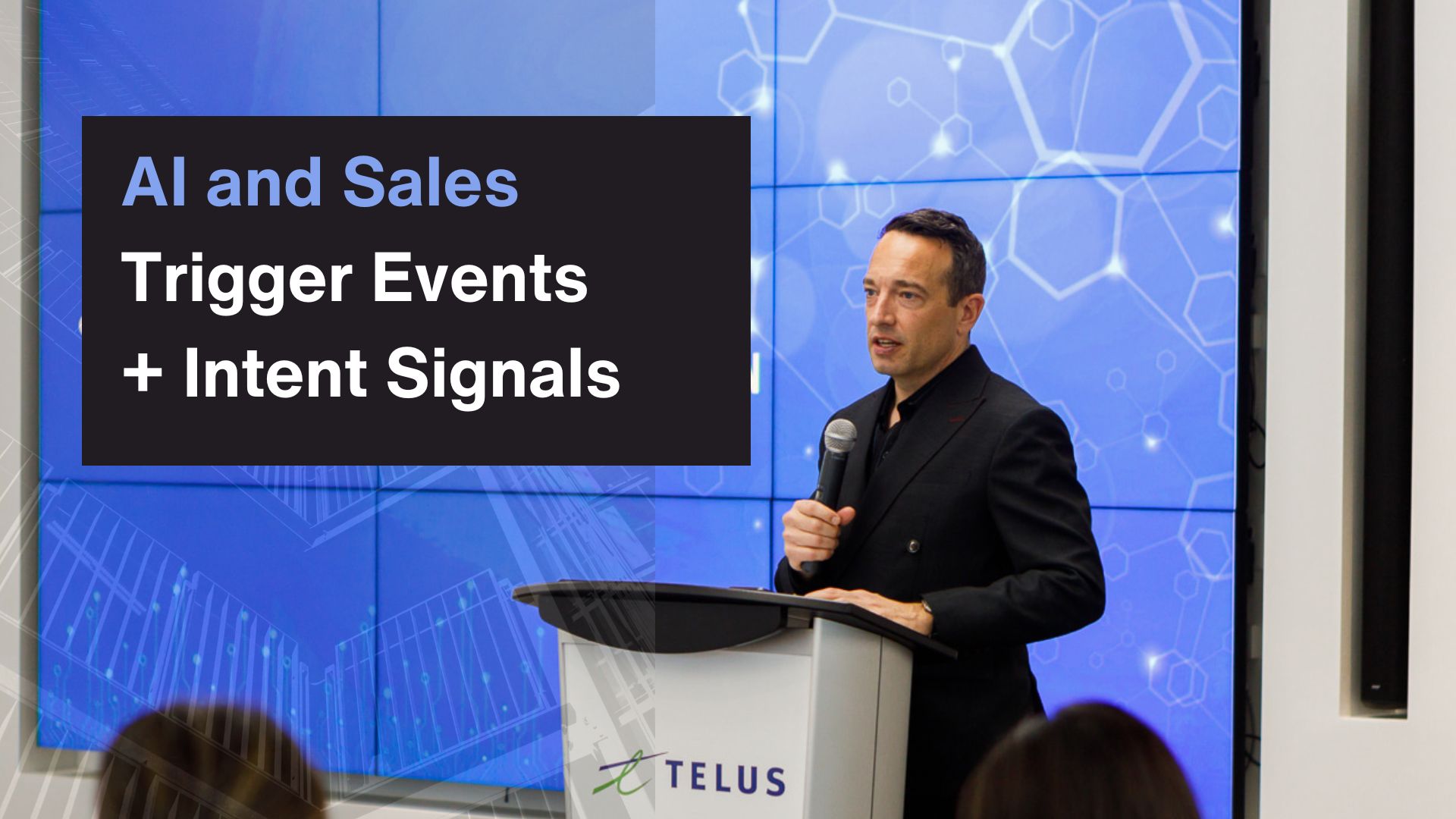How to Harness AI to Master Intent Signals and Trigger Events in Sales?
To succeed in selling we can now leverage AI to help us understand customer intent in almost real-time. The key to this is identifying “trigger events” and “intent signals,” concepts that, when effectively harnessed, can significantly boost sales success. This strategy was originally taught to me by my first sales mentor and father Bill Gibson – he called it “Situational Targeting.” Then Craig Elias helped me understand this at a deeper level when he introduced me to the concept of trigger events years ago.
What are Trigger Events in Sales?
Trigger events are specific occurrences that create an opportunity for sales engagement. These events indicate a shift in a prospect’s or client’s needs or priorities. Examples include mergers, acquisitions, leadership changes, product launches, expansions, or significant industry changes.
In our own personal life we experience all kinds of trigger events that drive us to start searching for a new product or service. That search often creates “intent signals.” I recently had the heel of my favourite boots come apart, that event is what will propel me to search for a replacement.
An HR leader who loses several new hires in a row may realize that their recruitment activity may not be attracting and assessing potential candidates well. Those trigger events (quitting or firing the new hires) can drive them to look for solutions to solve this pain.
Recognizing these events requires staying informed about industry trends. Sales professionals can use various tools to monitor these events and align their outreach efforts accordingly. Subscribing to industry newsletters, setting up Google Alerts, and using social listening tools can help sales teams stay ahead. There are also several AI driven sales tools that can help us automate and enhance this strategy.
What are Intent Signals in Sales?
Intent signals are indicators that a prospect is actively considering a purchase or is in the market for a specific solution. These signals come from the prospect’s online and offline behavior — website visits, attending specific conferences or industry events, registering for webinars, content downloads, social media engagement, and search queries. By analyzing these behaviors, sales teams can gauge the level of interest and intent of potential customers.
AI-powered tools have revolutionized the detection and interpretation of intent signals. Machine learning algorithms and predictive analytics sift through vast amounts of data to identify patterns and predict which prospects are most likely to convert. This allows sales teams to prioritize high-potential leads, improving efficiency and effectiveness.
What are the types of intent signals in sales to look for?
There are several types of intent signals that sales teams should watch for:
- Content Engagement: When a prospect or client frequently visits your website, reads your blog posts, or downloads whitepapers, it’s a strong indicator of interest.
- Engaging with Email: Opening an email or revisiting a proposal several times, sometimes months later is an intent signal salespeople should watch for.
- Search Behavior: Analyzing the keywords and search queries prospects use can provide insights into their current needs and challenges.
- Social Media Activity: Engagement with your brand’s social media posts, mentions, shares, or even following your company can signal intent.
- Third-Party Review Sites: Visits to review sites like G2 or Capterra to read reviews about your products or services indicate a prospect is in the decision-making stage.
- Email Interactions: High open rates and click-through rates on your email campaigns show that prospects are engaged with your content and are moving through the sales funnel.
Integrating Trigger Events and Intent Signals
My sales methodologies emphasize integrating trigger events and intent signals to develop a comprehensive approach to prospecting and engagement. By combining these elements, sales professionals can better understand their prospects and tailor their strategies to meet specific needs and timing.
For instance, a prospect who has recently undergone a merger (trigger event) and has been actively searching for CRM solutions (intent signal) presents a prime opportunity for a targeted sales pitch. Understanding the context provided by the trigger event, coupled with the demonstrated interest indicated by intent signals, allows sales teams to craft highly relevant and compelling messages.
If I sold pre-hiring assessments for a company like Prevue HR I might look for organizations who’s total head count isn’t growing but always seem to be hiring. I could then take that list and feed it into an AI based intent tool and see who on that list is actively searching for or showing an intent to buy.
AI for Sales Intent Infographic
An insightful infographic by Alexis Martial., a SaaS sales expert from Belgium, highlights several software tools essential for detecting and leveraging intent signals (see Infographic below).
- ZoomInfo: Provides comprehensive B2B contact and company information. Uses AI to analyze data and identify intent signals, helping sales teams pinpoint high-intent prospects and tailor their outreach efforts. (It’s not my favourite tool but it’s an industry leader)
- Bombora: Tracks online behavior across a vast network of websites. Aggregates data to deliver intent insights, enabling sales professionals to identify which companies are actively researching relevant topics.
- 6sense: Uses predictive analytics to uncover buying signals from anonymous website visits and other digital interactions. Helps sales teams prioritize leads based on their likelihood to convert.
- Demandbase: Combines account-based marketing with intent data to provide a holistic view of target accounts. Enables sales teams to personalize their outreach and engage with prospects at the right time.
- TechTarget: Offers intent-driven marketing and sales services. Tracks the research behavior of IT buyers, providing valuable insights into their interests and needs.
- G2: Collects user reviews and ratings for software products. Analyzes this data to identify trends and intent signals, helping sales professionals understand what potential customers are looking for and tailor their pitches.
- Wappalyzer: This tool helps you find the technologies used by a company by analyzing their website. It’s useful for understanding a prospect’s tech stack, which can inform your sales pitch and highlight compatibility with your solutions. Great for marketing SaaS providers and sales teams!
- Reveal: Reveal leverages your partners’ networks to uncover new leads and opportunities. By tapping into existing relationships, it helps sales teams discover prospects that might not be visible through traditional methods.
- Leadfeeder: Leadfeeder identifies companies visiting your website by matching IP addresses with their extensive database. This insight allows sales teams to follow up with interested parties who haven’t yet reached out directly.
- Segment: Segment tracks user interactions across various platforms and helps you understand user behavior by aggregating data into a single view. It’s particularly useful for tracking users who have reached a certain threshold of engagement, signaling readiness for outreach.
- Owler: Owler provides key company insights and monitors changes within organizations. This information helps sales teams stay updated on potential trigger events, such as leadership changes or funding rounds, which can be prime opportunities for engagement.
- Clay: Clay aggregates over 50 data signals in one place, providing a comprehensive view of prospects. It combines data from various sources, enabling sales teams to make informed decisions based on a holistic understanding of a prospect’s behavior and needs.

Combining AI and Human Curiosity in Your Sales Process
Leveraging AI to harness intent signals and trigger events is crucial for modern sales strategies. These elements help sales professionals gain deeper insights into their prospects’ behaviors and needs, allowing for more precise and effective engagement.
By staying attuned to these signals and events, sales teams can significantly enhance their ability to close deals and drive success. With the right tools and a keen understanding of these concepts, sales professionals can unlock new levels of performance and achieve their goals more efficiently.
It’s also very important to note that before AI it was also possible to identify trigger events and intent signals during an initial sales call. I often ask inbound prospects two simple questions “How did you find us?” and they will often answer “Google.” My next question is “Just out of curiosity, what did you search for?”
Sometimes they say something like “Sales leadership training” or “Keynote Speaker on AI.” My next question will be “What piqued your interest about a keynote on AI?” In many cases they will share both their trigger event and why they felt that topic is important to their business. This won’t just help with finding a deal, triggers and intent also help us book discovery calls, personalize proposals and give us the right verbiage to engage senior executives in the close.


